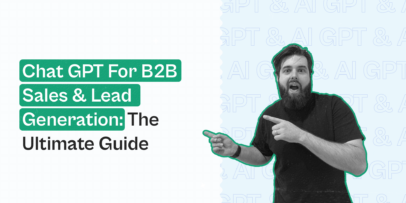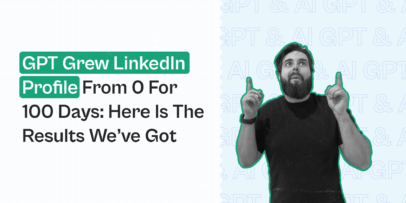15+ Rules For Crafting Effective GPT Chat Prompts
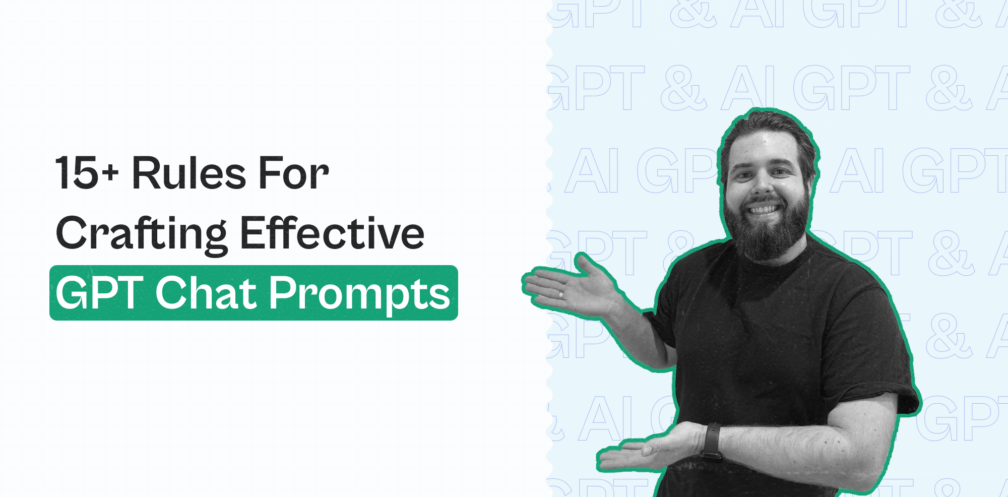
ChatGPT can be one of the best or one of the worst tools part of your marketing stack.
It all depends on how you use ChatGPT effectively.
The truth is, ChatgPT can be incredibly effective for lead generation, content creation, and even outreach.
But most people just use the AI for creating content.
Granted, it can produce some solid text sometimes. That is, if you only use the right prompts.
The problem many people encounter though, is getting responses that are too robotic, inaccurate, or overall, not very human.
Wondering how to use ChatGPT effectively?
The difference between the right prompt and getting a stiff, robotic text is night and day.
It’s all about the ChatGPT prompts you use.
Here’s an example.
BAD prompt:
- Create an article on LinkedIn automation.
GOOD prompt:
- I run a LinkedIn marketing and outreach agency targeting funded startups. I want you to create a sales proposal focusing on their specific needs and pain points for lead generation. But give me the outline first, don’t create the full thing. Focus on their objectives and how to overcome them.
The difference is obvious, right?
One way to level up your ChatGPT prompts is by simply giving the AI a persona. This way, you get more experienced replies.
If there’s one thing you’ll take away from the article, it should be that your ChatGPT prompts should include:
- [Your persona]
- [Your knowledge]
- [Your traits]
- [Steps to the task]
- [Your task]
- [Goal]
- [Format]
Now, if you’re looking for more ChatGPT prompts best practices, examples, and proven ChatGPT prompts you can directly copy and adjust for your business…
Including potential personas, traits, and other ChatGPT best practices to keep in mind.
Here’s what we’ll cover to learn how to effectively use ChatGPT:
- What you need to know about ChatGPT, before focusing on the prompts.
- How do ChatGPT prompts work?
- 15+ proven prompts and best practices to effectively use ChatGPT.
- Other proven ChatGPT prompts and anatomy examples for structure.
How Does ChatGPT Work, Exactly?
Now, we won’t get super into detail about how large language models (LLMs) work.
But first, let’s break down how ChatGPT works, before taking a look at ChatGPT prompts.
Essentially, the AI is a super-sized computer program that can understand and produce natural language.
A large language model is a type of AI system designed to understand and generate human language. Then, through deep learning techniques, the AI is able to process and generate text at a scale that was previously challenging to achieve.
What does this mean for your ChatGPT prompts?
Any kind of output you get from the AI will be trained on existing datasets such as:
- Common crawl: Collection of text pulled from billions of web pages containing trillions of words.
- WebText2: A library of over 45 terabytes of text data
- Persona-Chat: OpenAI’s own dataset that comprises over 160,000 dialogues between participants with unique personas.
- And much, much more.
That said, the effectiveness of your ChatGPT prompts depends entirely on how you use the tool.
Below, we’ll cover all the proven prompts and templates you need to know about.
But first, let’s explore what causes your prompts to be ineffective.
Why are my ChatGPT responses inaccurate?
One common issue people face with ChatGPT prompts have to do with their replies being inaccurate.
Another important thing to keep in mind is that the AI system has been trained only using data up to September 2012.
Though, multiple factors can contribute to the AI’s inaccuracy.
Few things to keep in mind if you’re wondering how to prompt ChatGPT accurately.
- The AI is only as good as the data it’s trained on. Data is created by human trainers and vast amounts from the internet, which can often be inaccurate or just wrong.
- ChatGPT is NOT a search engine. Instead, look at it like a text completion tool, that calculates the most likely outcome for the next word, query, or prompt.
- Finally, the AI is often unable to give a specific source, URL, or reference material. That’s because ChatGPT is trained only until 2021, but also, online material and content often change. So, it’s not uncommon to receive URLs from ChatGPT that lead to 404 error pages. That might be because the URL has changed since the training phase, the author edited the page, or the AI is plain wrong.
Now, before we get to ChatGPT best practices, let’s take a look at how the AI prompts work.
What’s In A ChatGPT Prompt? Overview On How To Prompt ChatGPT Effectively
How to use ChatGPT effectively depends entirely on your prompts.
A prompt is a short piece of text that serves as the starting point for ChatGPT’s response.
And with the right prompt, you’re practically unstoppable.
The technology is trained on large amounts of data to understand how people communicate and respond to certain questions or statements.
Machine learning specialists leverage the power of collecting large-quality data to train the models. ChatGPT, in particular, is reportedly trained on more than 45 terabytes of text – including conversations, news, blog posts, books, and other text.
However, one important thing to keep in mind about its accuracy is that ChatGPT finished its “training” in 2021.
So, for certain prompts, it might not produce the most accurate or reliable info (i.e. for news after 2021, for example).
While it may be tempting to copy ChatGPT’s answers directly to your blog or cold email, it’s always worth double-checking for accuracy, reliability, and overall cohesiveness.
So, before we continue on how to prompt ChatGPT (and our proven templates) here are some general tips to keep in mind:
- ChatGPT processes up to 4,096 tokens in an input, any character beyond that is ignored without a message. A token is roughly equivalent to a word, depending on the use case.
- The response generation can be stopped with the stop button above the input field if you notice ChatGPT is going in the wrong direction with your prompt.
- If there has been too much exchange during one session, it may be helpful to start a new chat so that subsequent replies are not corrupted or based on prior information.
- As an AI language model, the tool doesn’t have a specific limit on the maximum number of words it can include in a response. So, in theory, it can write a 5,000-word blog post if needed.
- The tool can’t give you “hidden” data (e.g. how much search volume a keyword has).
- As of February 1, 2023, OpenAI has introduced ChatGPT Plus. Currently, it costs $20/month, is available even when demand is high, provides a faster response speed, and priority access to new features.
And according to OpenAI, the limitations are as follows:

16 Prompts And ChatGPT Best Practices On How To Use ChatGPT Effectively
If you’re wondering how to effectively use ChatGPT, this section is for you.
As you might have realized from above, a lot of this has to do with the ChatGPT prompts you use.
So, to level up your prompts, here are some ChatGPT best practices to keep in mind when using the AI:
- Give ChatGPT an identity (“act as…”) and an intended audience.
- Offer and give specific context.
- Include helpful and relevant information upfront.
- Highlight what information to include.
- Highlight what information to exclude.
- Choose a relevant tone of voice and writing style.
- Give examples to base the response on.
- Include the length of your responses (e.g. under 280 characters for Twitter).
- Model specific expressions.
- Ask to add emojis and simplify text.
- Ask to add “uncommon ideas” and analogies for your text.
- Give the AI a structure to follow.
- Specify the format of the response.
- Chain multiple prompts.
- Test your prompts first.
- Considering ChatGPT Plus.
Let’s take a look at each approach with examples.
1. Give ChatGPT an identity (“Act as…”) and intended audience
This can be one of the best ways to go from getting an AI-sounding response to something more usable.
With this approach, you’re telling ChatGPT what role the AI should play. So that its response is better suited for a specific target group or communication channel.
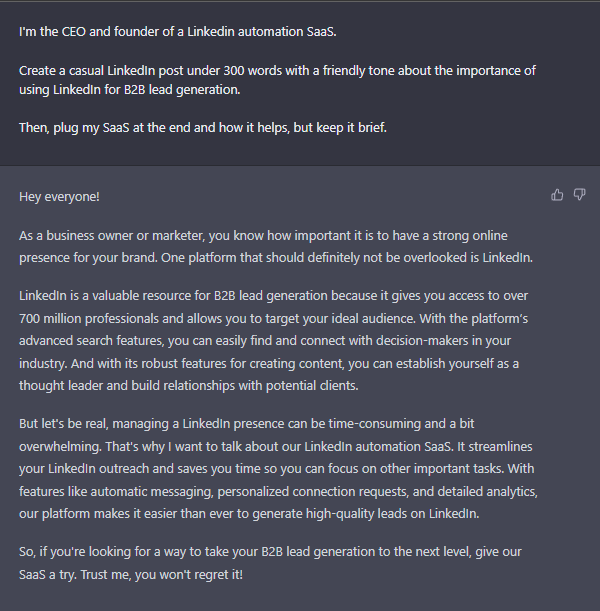
Some other possible identity prompts might include:
- Acting as a legal expert: What are some pain points law firms use with their content marketing to educate clients and attract new businesses?
- Act as an FBI hostage negotiator and teach me some psychological tricks to convince a client to accept new prices.
- You’re a head content marketer of a proven agency that knows how to generate leads, I’m the founder of a LinkedIn automation SaaS. Give me 5 blog post topics I could write about that would help me generate leads.
- You’re a SaaS copywriter with 10+ years of experience. Critique the following headline and give me 5 actionable suggestions to improve it.
- As a social media expert, can you create a LinkedIn post for me under 300 words based on the following article…
If unsure, remember the following approach when giving ChatGPT an identity:
- [Your persona]
- [Your knowledge]
- [Your traits]
- [Steps to the task]
- [Your task]
- [Goal]
- [Format]
Then, putting this all together, you might get something like this:

While it’s not perfect as it could be more detailed, for a response generated in under 10 seconds, it has a lot of potential.
2. Offer context
As an AI, ChatGPT will always perform better with context.
On its own, most generated text might sound robotic. That’s because ChatGPT doesn’t know what you’re trying to achieve.
For example:
Bad prompt: Create a post about productivity.
Response: “Productivity is one of the most important aspects of success in both personal and professional life. It is the ability to accomplish more in less time and achieve your goals efficiently. However, with so many distractions and interruptions in our daily lives, it can be challenging to stay focused and productive. In this post, we’ll explore some practical tips to increase productivity and achieve your goals…”
Better prompt: Create a LinkedIn post under 200 words about the importance of productivity and time management for small business owners.
Response: “Productivity and time management are crucial for small business owners. Every minute counts, and how you spend your time can make or break your business. By improving your productivity and time management skills, you can accomplish more in less time, stay focused on your goals, and achieve success faster. Set clear goals and priorities, eliminate distractions, and manage your time effectively using tools like calendars, scheduling apps, and time-tracking software. Delegating tasks and outsourcing can also free up your time to focus on the most critical aspects of your business. Don’t let wasted time and lack of productivity hold your business back – invest in your skills and achieve success! #productivity #timemanagement #smallbusiness #entrepreneur”
The difference is obvious, right?
Here are some more examples:
Bad prompts:
- Create a cold email.
- Write a good LinkedIn connection request.
- Create a cold calling script for small business owners.
Good prompts:
- Create a cold email under 100 words targeting agency owners. In the email, briefly explain how their target audience can be found on LinkedIn and why it’s a good idea to use automation to connect with them, instead of manually writing the same connection request. Then, ask if they’d be interested in a free, 7-day trial.
- Create a LinkedIn connection request under 300 characters targeting agency owners. Include 2 emojis, keep it friendly, and don’t sound robotic.
- Imagine I’m cold-calling marketing agency owners in my area. Create a sales script, making sure to:
- Ask for their permission to hear the pitch without coming across as too sales-y.Come across as friendly and casual.Overcome any potential objections they have (assuming I’m selling lead generation as a service).Don’t make it all about me.Finally, include placeholders for any information you might not have.
3. Include helpful and relevant information upfront
Did you know you can include information for ChatGPT to base its response on?
This is extremely useful if you’re creating text based on research or pre-defined content.
You can even paste the full reference directly.
Here are some prompt examples with this in mind:
- The following text is my resume. I want you to remember it and tell me once you do that first.
- Then, given the above information, write a witty speaker bio about me under 150 words.
- The following text is an article from our blog. Summarize the content and create a social share text under 200 words for my LinkedIn profile. Keep the tone friendly and casual.
- The following is a question a lead asked me. Give me 3 different ways I can overcome those objections and reply to them. Take into consideration that I’m an expert salesperson and marketer.
4. Highlight what information to include
Similarly, you can be more direct with your prompts to get more specific information in your responses. Such as:
- I’m booking a discovery call with a lead from an industry I’m not very familiar with. Can you give some examples of questions I should ask and what should be included in the meeting agenda?
- I need to prepare a presentation for a potential investor on
. Can you give me some guidance on what to include? - I need to write an email to a client regarding a change in the project timeline. Can you give me some guidance on how to phrase it?
5. Highlight what to exclude
Alternatively, you can exclude certain information you might already know or not need.
For example:
- I want you to create a LinkedIn post under 200 words targeting agency owners and their pain points about lead generation. Then mention how they can overcome those pain points. However, do not call out the target audience by name and exclude any information about ads. End the post with a call-to-action to message me if they have any questions and exclude and sales-y text.
6. Choose a relevant tone of voice and style
By default, ChatGPT text might sound robotic or very bland.
And since almost everyone’s using the tool nowadays in their outreach or writing, it can be easy to spot such text.
As you can see, this sounds very monotonous and most people will notice it’s written by an AI.
That’s largely because most people don’t include the context (see above) and tone of voice in their ChatGPT prompts.

But by choosing a relevant tone of voice and writing style, we can take it a step further.
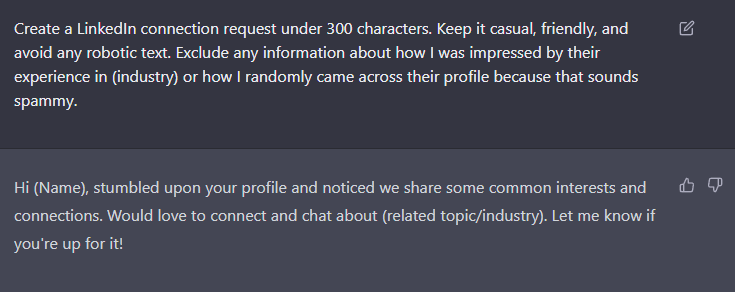
7. Give examples
ChatGPT is based on terabytes of studied data and text.
However, you can also give it examples to “remember” and create a response based on that!
Examples here may include:
- Your current articles.
- Research text.
- Social media posts.
- Ads.
- Writing style.
- And more.
Though, keep in mind, as an AI language model, ChatGPT is capable of analyzing text and learning it to generate content. It can’t crawl websites on its own. So, you’ll have to provide it with the text yourself.
However, it CAN go through certain websites to analyze and keep in mind that particular writing style.
Here’s an example:
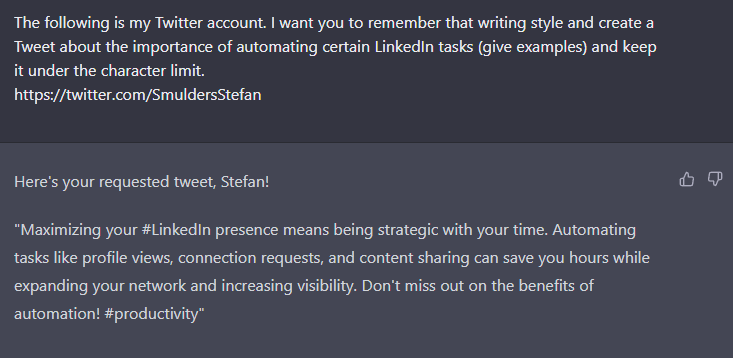
And one more.

8. Include the length of your response
When creating your GPT prompts, it’s also important to include a word count for the response.
For example, if you want the AI to create a post, without a word count, it might think a blog post and create something unnecessarily long.
Here are some example prompts:
- Write a 100-word summary of the following article.
- Create a LinkedIn post under 200 words about [topic].
- Write a cold email under 100 words, taking into consideration…
9. Feed it specific expressions
As an AI model, ChatGPT might not have the most creative writing style on its own.
However, this can be fixed by telling it to model the response based on:
- Specific expressions with examples.
- The writing style of a famous person.
- Specific format or tone of voice.
Here are some prompt angles with this in mind:
- Create an article about (topic) in the style of Neil Patel.
- Create a funny email about (topic) with the tone of (influencer or celebrity).
- Include the following personalization (information) in the following (message).
10. Ask to add emojis and simplify the text
Another simple way to add personality to your AI writing is by asking it to include emojis.
This can be particularly useful for social sharing text (e.g. social media) and to avoid repetitive tasks.
Here’s an example:

Other ways you can get it to change your text include:
- Simplify the following text by decreasing the readability score.
- You’re a content editor with 5+ years of experience. I want you to simplify the following text for (target audience).
- How can the following text be improved?
11. Ask to add “uncommon ideas” and analogies for your text
If you’re not feeling very creative, you can get ChatGPT to come up with few different ideas or analogies to describe your topic.
Remember, on its own, ChatGPT can sometimes create stale and robotic text.
But with the right prompt, you can even create poems and get very creative.
This comes in handy when creating outreach text or even inbound text (e.g. landing pages, blog posts, etc.).
That said, here are some prompts to boost your GPT creativity:
- Create an analogy for what it’s like to use LinkedIn automation.
- Create a short haiku about LinkedIn automation.
- What are some creative topics I can compare LinkedIn automation to for my marketing?

12. Give ChatGPT a structure to follow
To level up your ChatGPT replies, you can even get the AI to use a particular writing structure.
This can be particularly useful for writing emails or any other form of outbound lead generation text. Especially if you’re building a prospect list and want to combine ChatGPT features with Google Sheets.
For more info on that, see our guide on using ChatGPT for lead generation, but we’ll also show you how to integrate the AI with Google Sheets below, so, keep on reading.
Here’s an example of a GPT prompt based on a specific structure:
- Use this email opening example: “Yamini, I notice that you’ve been the CEO of HubSpot since 2021 and I wanted to reach out” to write a casual email that is 50-100 words, consider that the person we’re reaching out to is named {full_name} and they are the {title} of {company_name} since {formatted_date}. Include a 1-2 sentence case study of how we (case study example) and end with a CTA to book a 10-minute call.
Then, let’s say we have those placeholder personalization tags in a spreadsheet file, the response would look something like this:

13. Specify the format of the response
Did you know you can guide ChatGPT’s output by providing the format of the output text you’d like?
This can be particularly useful for your content marketing and SEO strategy.
And the best way to explain it is with an example.
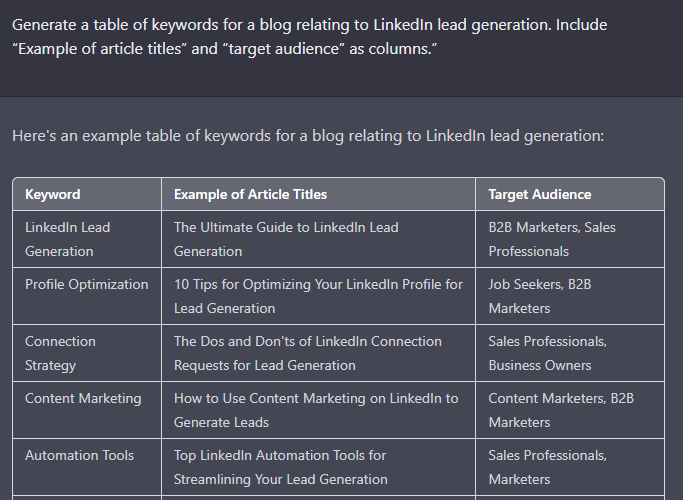
While ChatGPT can’t give search volume for SEO keywords, for ideation and target audience research, it works really well.
14. Chain prompts
Chained prompting is a way to break up complex tasks into several intermediate steps to generate more concrete, customized, and overall higher-quality results.
This way, you can also edit and improve your prompts as you go.
For example, if you create an article by chaining prompts, you can give “feedback” as you go. If not, you’ll end up with a full article that might be harder to edit.
Here’s an example:
- I want you to create an article about (topic) and (details). We will do it prompt-by-prompt. First, I want you to give me an outline of an article about (topic).
Then, once you get your response, you can give it feedback and continue with the prompt:
- Exclude the section about (topic) and instead, add (topic). Now, write the introduction section – which consists of a headline, teaser, and a table of content.
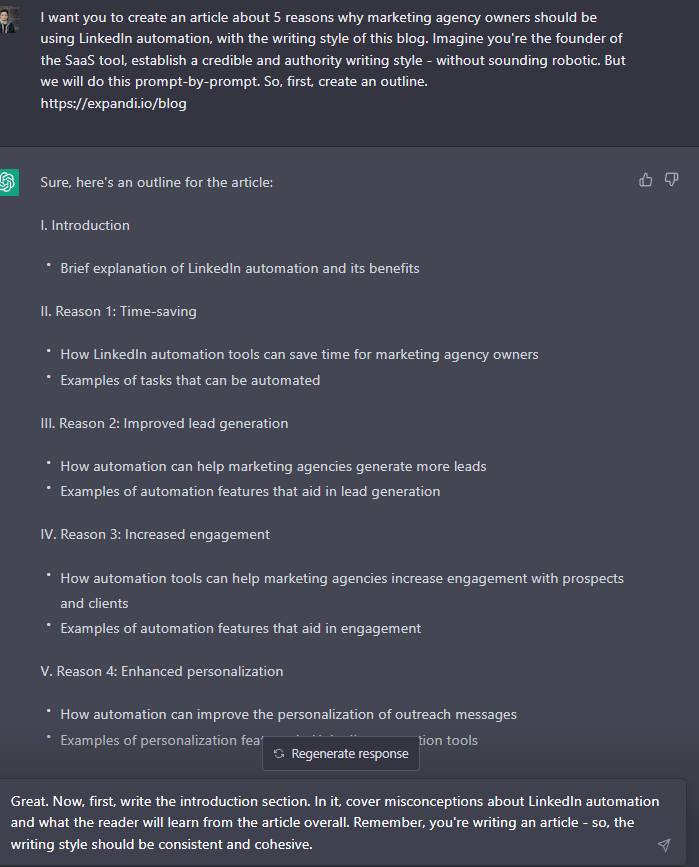
Then, you move section by section until you’re done!
15. Test your prompts
Before we wrap up this section, it’s worth noting that the best way to master ChatGPT is by constantly testing your prompts and being curious.
Once you understand how the AI thinks, consider letting your mind run free and think of different approaches.
As you’re testing, you’ll see certain variables come up, such as the maximum length of the prompt and the reply, writing style and tone, ChatGPT integrations, and other use cases.
So, you need to write, test, refine, and test some more until you consistently get an outcome you’re happy with.
Note down what bad and good prompts look like and continue experimenting with different prompts for your business.
16. Consider ChatGPT Plus
Finally, if you find yourself using a lot of ChatGPT, you should consider upgrading your plan.
Since as of now, the demand is very often high because many people are constantly experimenting with the AI tool.
With ChatGPT Plus, you pay $20/mo and get:
- First access when demand is high.
- Faster response speed.
- Priority access to new features.
The last one in particular might be very interesting if you want to get ahead.
Now, let’s get back on track.
Below, we’ll cover more prompt anatomies with examples, and then some proven ChatGPT prompts for outbound lead generation.
Other Proven ChatGPT Prompts And Prompt Anatomy Examples On How To Use ChatGPT Effectively
As mentioned above, to get the most out of ChatGPT responses, you need to structure your prompts accordingly.
Some of the most popular entries include the following:
- “I want you to act as ___ for ___”
- “Your task is to ___”
- “___ should ___”
- “___ should not ___”
- “To get started, please ___”
- “Assuming I am ___, what would be the best way to ___”
- “Your job is to ____, I want you to___”
- “I am ___. You are ___.”
- “For ___ target audience. Create ___.”
- “Assuming ___. How do I ___”
- “You will be in charge of ___ as ___ with ___. Then, I want you to ___”
Here are some examples of what these ChatGPT prompts might look like in practice:
- I want you to act as a personal assistant for scheduling appointments.
- Your task is to generate creative ideas for a marketing campaign targeting a younger demographic.
- To get started, please provide a summary of the key features of the new software update.
- Assuming I am a novice gardener, what would be the best way to start a small vegetable garden?
- Your job is to analyze market trends, and I want you to present a comprehensive report on potential investment opportunities.
- I am a student. You are a knowledgeable tutor. Help me understand the principles of quantum mechanics.
- For a tech-savvy target audience, create a tutorial video demonstrating how to set up a smart home system.
- Assuming limited budget constraints, how do I plan a memorable and cost-effective wedding?
- You will be in charge of customer service as a representative with expertise in troubleshooting technical issues. Then, I want you to compile a list of common problems and their solutions.
Then, once you receive a response from the AI, you can reply with the following to optimize and tweak its replies:
- Effective communication should be clear and concise.
- Feedback should not be dismissive or condescending.
- Make it shorter/direct/funnier, and so on.
Similarly, you can use the following “mega prompt” approach:
- Simulate person or role.
- Complete or do task.
- Steps to complete task.
- Context / constraints.
- Goal.
- Format output.
Remember, the constraints you can include are essentially useless.
So, it might be useful to have a handful of “personas” at hand for your prompts that you can copy and paste accordingly.
Personas for:
- Your target audience and ideal customer persona.
- A “supervisor” role to manage, edit, or adjust your work.
- An expert to create optimized, expert text.
- And more.
If you find ChatGPT still giving you boring, or robotic replies, consider adding examples of the kind of work you’re looking for.
Or, if you’re looking for very specific use cases, you can even create your own GPT.
Conclusion
So, that’s a wrap.
Hopefully, you have a better understanding of how to get better replies from ChatGPT now, using the above ChatGPT prompts and best practices.
Remember to include the following elements in your ChatGPT prompts and you’ll be on the right track:
- [Your persona]
- [Your knowledge]
- [Your traits]
- [Steps to the task]
- [Your task]
- [Goal]
- [Format]
But if you truly want to unlock the full potential of ChatGPT, you might want to check out our full eBook on the topic here:
In it, we also cover:
- 50+ proven AI prompts.
- Direct, copy-paste formulas you can use and adjust for your business.
- How to use the AI tool for all steps of your outbound lead generation.
- Which personas work and which ones don’t.
- How to get ChatGPT to emulate your exact writing style so you don’t have to spend hours editing.
- And more.
You’ve made it all the way down here, take the final step

